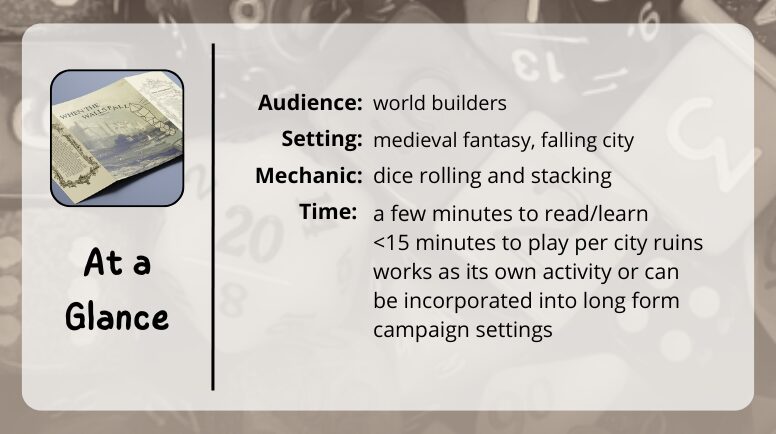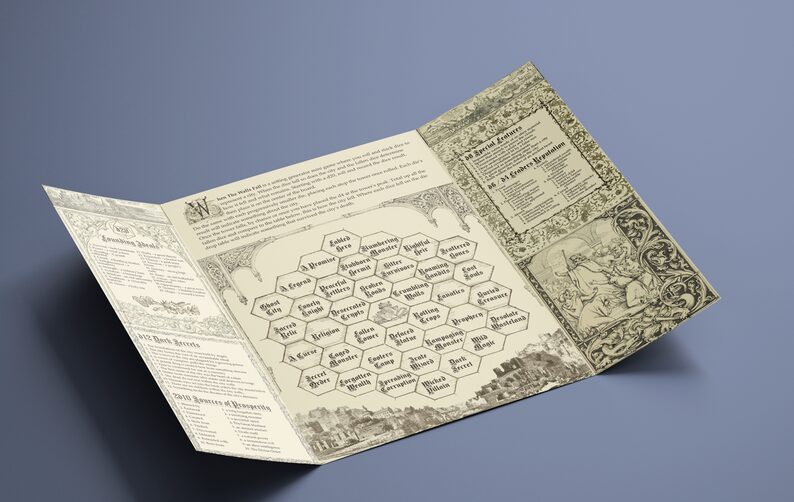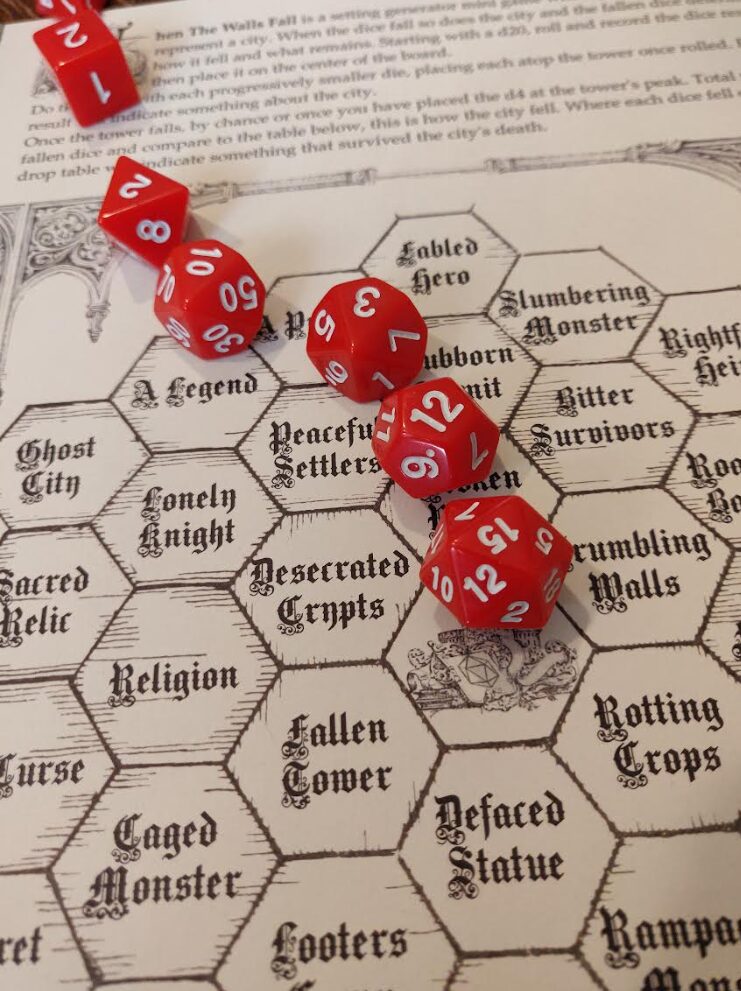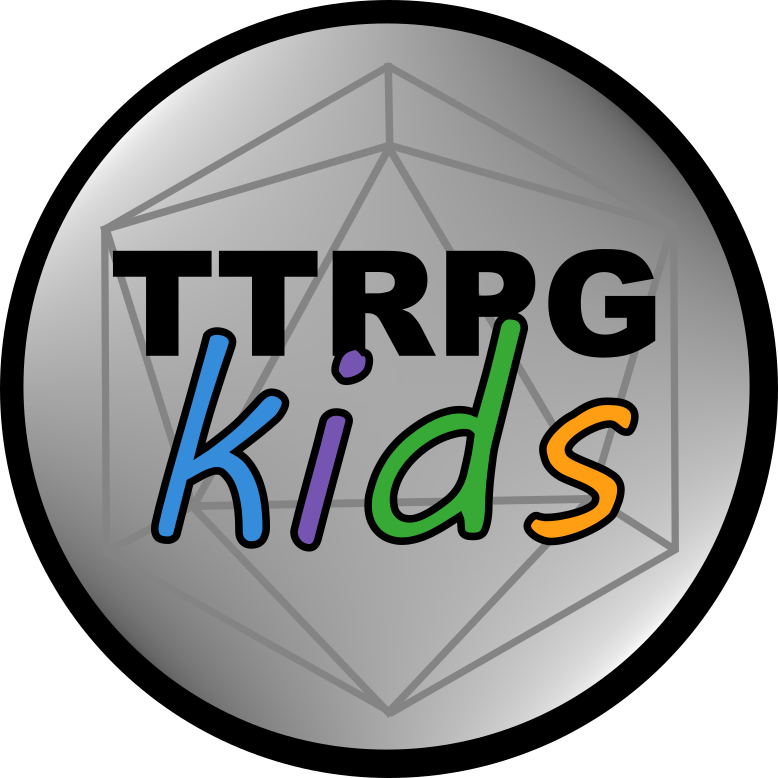Review of When the Walls Fall, a dice stacking setting generation game
Having a setting to play in a core part of tabletop RPGs, and that part of the game can be a game itself too! When the Walls Fall by Molomoot helps you create tabletop RPG settings by stacking dice… and seeing how they, and your city, all fall.
Jump to:
- Audience for When the Walls Fall
- Setting for When the Walls Fall
- Mechanics in When the Walls Fall
- Overall thoughts on When the Walls Fall
- Find a copy of When the Walls Fall

Audience for When the Walls Fall
When the Walls Fall is about creating a post-collapse city or ruins to include in your game setting (or as a standalone fun exercise), and its primary mechanics is rolling dice to generate the city… and stacking dice until the tower collapses.
The target audience is probably going to be folks who want an engaging way to include the table in generating a TTRPG setting, who are looking for campaign ideas, or want a short world-building game/exercise to do solo or with their players.
Because it’s dealing with a city falling, that’s going to be part of the theme content that may require explaining to really young players, but also… there wasn’t anything in here that I didn’t feel comfortable explaining to my 7 year old. I would say that content should be alright for most folks as long as they are OK with the concept of a city ending and some talk of like… explaining an illegitimate heir coming for the throne.
For mechanics, players will need to roll dice and read the matching result from various tables or a map, so there’s a low barrier to mechanics. Some fine motor skills abilities are needed for dice stacking, but, also… if the tower falls a little early, that’s OK too and will still generate a scenario.

Setting for When the Walls Fall
When the Walls Fall is going to generate the setting, which is city ruins that are most aligned with medieval fantasy themes. There’s mentions of magic, deities, rulers, and heroes along with city economic structures, architectural elements, and social constructs. The game builds up this city and then destroys it, leaving behind remnants for later exploration.
This was really cool because, if you create it as a group, players have had a hand in making this rich environment, watching it fall, and then diving in to explore secrets that they know about but that maybe their characters have only heard through rumors. If it was created by a GM in secret, the GM can now have a well fleshed out post-apocalyptic setting that players can explore, and the GM has all this lore waiting for them to find!
For ours, we ended up with a city like this:
- Founded on opportunity – bisected by a great river
- The first stone of the city was the heart of a titan (which probably has some magical ability)
- Its prosperity comes from a stolen powerful spirit
- Crystalline monuments dotted the city’s streets
- The leader was largely absent as they were disinterested in ruling
- It fell because its source of prosperity was stolen
- After the fall, a few things were left behind, including broken roads, peaceful settlers, and a stubborn hermit

And… that sounds like some fun ruins to explore! There’s some NPCs that can tell stories of the past and plenty for players to discover or seek out (including finding the stolen and re-stolen spirit, uncovering the secrets of the titan’s heart, or maybe event tracking down the absent ruler if they weren’t in the city at the time of the fall).
Mechanics in When the Walls Fall
Mechanics in When the Walls Fall are really easy to follow while being able to create a setting as detailed as what’s above… and probably generating some cheers when your dice tower eventually collapses.
You’ll roll dice in order (from d20 to d4 in a standard set of 7 TTPRG dice) and compare the number that you rolled to the tables in the game. Once you’ve rolled a die, you add it to a dice tower that you start creating in the middle of a grid map. When your tower falls (either due to a player mishap or from flicking it over when the d4 is placed), you’ll total up your dice to compare to a final table that tells you how things all ended…. And you’ll see where your dice physically land on the grid map for what’s still there.
All of this was very intuitive and tactile, and it took about 2 minutes for me to explain to kiddo. When our tower eventually fell, it was such a celebration at destroying this city, and we’re planning on using the ruins generated above (or one of the other ones we made because… we did this a few times for fun) in our next game.
Overall thoughts on When the Walls Fall
When the Walls Fall was a fun, short, creative exercise to do with the family, and it gave us a great seed for starting future adventures. It’s easy to understand and comes with PLENTY of great prompts to kick off worldbuilding together, and I’d recommend it as either an aid for your next game or as a quick storytelling activity on its own!
Find a copy of When the Walls Fall
You can find a copy of When the Walls Fall on the Molomoot itchio page!
If you liked this post, make sure to subscribe to the TTRPGkids monthly newsletter to stay up to date on the latest reviews, tips and tricks, game and podcast list updates, and more! Thank you for playing tabletop RPGs with your kids and sharing this awesome hobby with the next generation!


